
Sheet mulching vs deep mulching Illustration
Sheet mulching involves layering organic materials like cardboard or newspaper beneath mulch to suppress weeds and improve soil structure, while deep mulching incorporates thick layers of compost or mulch directly into the soil, enhancing moisture retention and nutrient content. Deep mulching promotes deeper root growth and long-term soil fertility, whereas sheet mulching primarily acts as a barrier to weeds and surface moisture evaporation. Choosing between the two depends on garden goals, with sheet mulching ideal for weed control and deep mulching better for enriching soil health.
Table of Comparison
| Feature | Sheet Mulching | Deep Mulching |
|---|---|---|
| Definition | Layering organic sheets to suppress weeds and improve soil. | Applying thick layers of organic material to deeply enrich soil. |
| Depth | Surface level, typically 2-4 inches thick. | Extends 6-12 inches deep into soil. |
| Purpose | Weed control, moisture retention, soil building. | Intensive soil conditioning and nutrient replenishment. |
| Materials Used | Cardboard, newspaper, compost, straw. | Wood chips, leaves, compost, manure. |
| Application Time | Quick to set up, ideal for garden beds. | Time-intensive with soil preparation needed. |
| Best For | Organic weed barrier in small to medium areas. | Long-term soil improvement in large landscapes. |
| Cost | Low cost, uses recycled materials. | Moderate to high, due to volume of materials. |
Understanding Sheet Mulching and Deep Mulching
Sheet mulching involves layering organic materials such as cardboard, compost, and mulch directly on the soil surface to suppress weeds, improve soil structure, and enhance moisture retention. Deep mulching incorporates thicker, more substantial layers of organic matter like wood chips or bark, promoting prolonged nutrient release and deeper soil conditioning. Understanding the benefits of sheet mulching versus deep mulching helps optimize soil health and plant growth based on specific garden needs and soil conditions.
Core Principles of Sheet Mulching
Sheet mulching relies on layering organic materials like cardboard, compost, and mulch to suppress weeds, retain moisture, and build soil fertility. Core principles include creating a weed barrier, enhancing microbial activity, and improving soil structure through decomposition. This method contrasts with deep mulching by focusing on surface layering rather than incorporating mulch materials deeper into the soil profile.
Key Features of Deep Mulching
Deep mulching involves applying a thick layer of organic material, typically 3 to 6 inches or more, to improve soil health and moisture retention extensively. It enhances nutrient cycling by breaking down slowly, supports beneficial microbial and earthworm activity, and suppresses weeds effectively. Compared to sheet mulching, deep mulching creates a more substantial barrier that protects root zones and fosters robust plant growth over time.
Materials Commonly Used in Each Method
Sheet mulching commonly uses organic materials like cardboard, newspaper, straw, and compost to create a layered barrier that suppresses weeds and retains moisture. Deep mulching typically involves thicker, bulkier materials such as wood chips, bark, and coarse compost to provide long-lasting soil enrichment and improved aeration. Both methods rely on natural, biodegradable substances to enhance soil health and promote plant growth.
Soil Health Impacts: Sheet vs Deep Mulching
Sheet mulching improves soil health by creating a nutrient-rich organic layer that enhances microbial activity and prevents weed growth, while deep mulching promotes deeper soil moisture retention and root development by incorporating organic matter directly into lower soil layers. Sheet mulching is effective for surface-level soil conditioning and gradual nutrient release, whereas deep mulching accelerates soil structure improvement and benefits deeper root systems. Both methods enhance soil fertility, but deep mulching offers more substantial impacts on soil aeration and long-term soil regeneration.
Weed Suppression Effectiveness Compared
Sheet mulching uses layers of organic materials like cardboard and compost to create a dense barrier that effectively blocks sunlight, reducing weed germination on the soil surface. Deep mulching involves applying thick layers of mulch that penetrate deeper into the soil, disrupting weed root systems and inhibiting their growth more thoroughly over time. Studies show deep mulching provides superior weed suppression by targeting both surface and underground weed propagation compared to the primarily surface-focused sheet mulching method.
Water Retention and Moisture Management
Sheet mulching involves layering organic materials like cardboard or newspaper with mulch to create a barrier that slows water evaporation, enhancing surface moisture retention. Deep mulching applies thick layers of mulch more extensively around root zones, improving soil moisture by reducing evaporation and promoting water infiltration to deeper soil layers. Both techniques effectively manage water but deep mulching provides superior moisture retention for deep-rooted plants by maintaining consistent hydration at root depth.
Long-Term Maintenance Requirements
Sheet mulching involves layering organic materials to suppress weeds and improve soil health, requiring periodic replenishment every 1-3 years to maintain effectiveness. Deep mulching incorporates a thicker layer of mulch, often exceeding 4 inches, which slows decomposition and reduces maintenance frequency, typically needing renewal every 3-5 years. Both methods enhance soil moisture retention and nutrient cycling, but deep mulching provides longer-term benefits with less frequent upkeep.
Best Situations for Using Sheet or Deep Mulching
Sheet mulching is ideal for suppressing weeds and improving soil fertility in garden beds or newly cleared areas by layering organic matter like cardboard and compost. Deep mulching works best for established trees and shrubs, providing long-lasting moisture retention and root protection through thick, woody mulch layers. Selecting sheet mulching suits transforming bare soil, while deep mulching supports mature plants that need substantial moisture and nutrient conservation.
Environmental and Sustainability Considerations
Sheet mulching enhances soil health by promoting organic matter decomposition and weed suppression, reducing the need for chemical herbicides, and conserving water through effective moisture retention. Deep mulching further improves carbon sequestration by integrating organic material deeper into the soil profile, enhancing microbial activity and nutrient cycling essential for long-term soil sustainability. Both methods reduce soil erosion and runoff, supporting sustainable landscape management while minimizing the environmental footprint of garden maintenance.
Sheet mulching vs deep mulching Infographic

 gardendif.com
gardendif.com